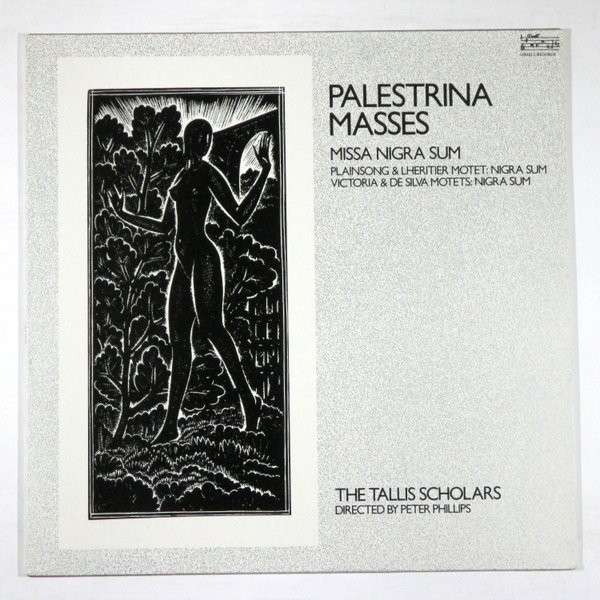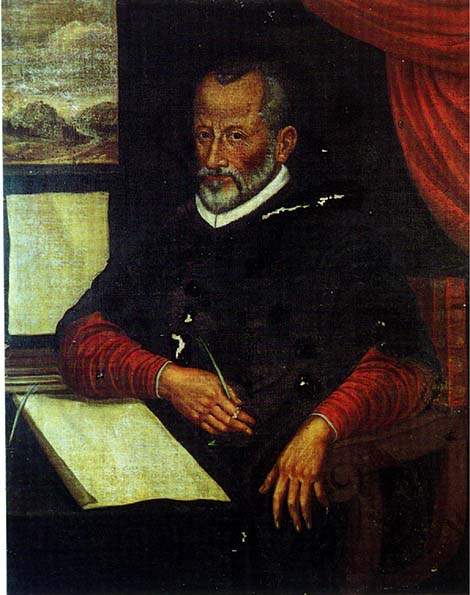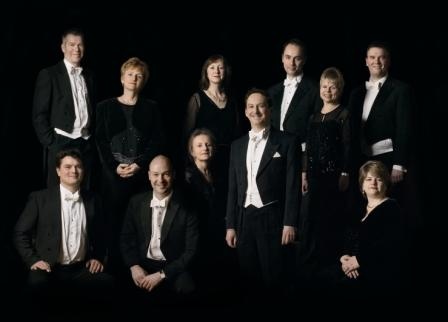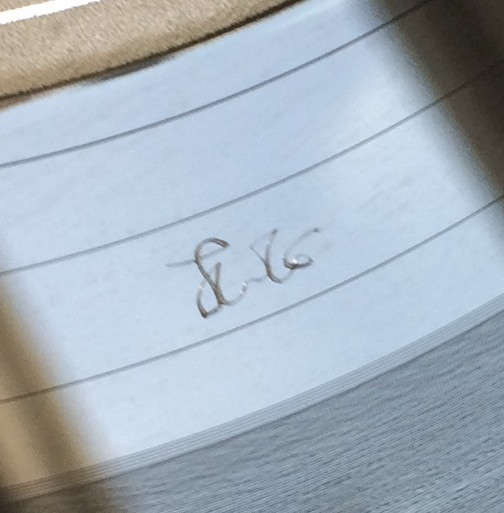
Giovanni Pierluigi da Palestrina, The Tallis Scholars, Peter Phillips
Palestrina Masses: Missa Nigra Sum
Album UK 1983 on Gimell label
Classical (Renaissance)
Produced by Steve C Smith and Peter Phillips It is rare to be able to highlight the music of Jean Lhéritier, the composer of the motet Nigra sum which Palestrina parodied. In the reverential atmosphere which has long surrounded Palestrina's music it has been thought that his style was born perfect, needed to change little during his lifetime and died with him, leaving theorists with a code of mathematical perfection which they have not tired of trying to crack to this day. The idea that he owed little to anybody in his formative years is attributable to the lack of any obvious predecessor: his music does not sound like Josquin's, and there are no major figures to bridge the gap between the two of them. Lhéritier, with de Silva, Penet and Morales, fills this gap; and on the evidence of Lhéritier's 5-voice motet Nigra sum, very obviously so. Lhéritier's music has much of the balance that is associated with Palestrina: the points unfold slowly and spaciously, the part-writing is sonorous. The principal difference is that Lhéritier wrote counterpoint throughout, where Palestrina added homophony to his general technique. Palestrina wrote 53 parody masses, of which 31 were based on music by other composers. Almost all these 31 models were by French, Flemish and Spanish composers, not Italians. This strongly suggests that Palestrina was showing his own appreciation of the Franco-Flemish style, and probably at the same time learning to write in it himself. Another feature of these 31 models is that almost all were available to Palestrina in print by 1563. It has been said (1) that the resulting 31 parody masses by Palestrina predate the 22 based on his own motets; and that they must be, in the broadest sense, apprentice works as Palestrina refined in his own way the styles of those he most admired. This recording shows what he gained from Lhéritier. The text for the plainchant Nigra sum, sed formosa combines three Marian antiphons, Nigra sum, Iam hiems transiit and Speciosa facta es, sung now at Second Vespers for common feasts of the Virgin; with the Alleluia placed at the end of each antiphon, the plainchant is proper to the Easter period. It will be seen from the words how church authorities have tried to tame the erotic imagery of the Song of Songs and make it serviceable; the effusions of praise are reinterpreted to refer to the Virgin Mary. Jean Lhéritier (c.1480-after 1552) was a French disciple of Josquin, and widely known in his own time - copies of his music may be found in Poland and Bohemia, even though he himself worked in France and Italy. He joins Josquin's style to Palestrina's by developing the technique known as ad imitationem, or using imitation consistently, which he then helped to make more generally known throughout Italy. That his melodies can be described as presenting 'nicely balanced arches... resulting from predominantly step-wise motion' (2) is tribute to his influence on Palestrina. Lhéritier was clearly impressed by this text, since a four-part and six-part version survive in addition to this five-part one. It is not very closely based on the chant, though two phrases carry through to him, to Palestrina and to the other settings by Victoria and de Silva: the falling and rising third and the falling scale. In the motet the third can be heard on the same words - 'sed formosa' - and the scale at 'ideo dilexit'. The motet and Palestrina's mass, including the second Agnus, are scored for soprano, countertenor, two tenors and bass. The Missa Nigra sum (first published in 1590, but written many years earlier) follows its model unusually closely. Whereas with the Missa Benedicta es (recorded on CDGIM 001) Palestrina has had to adapt Josquin's music very noticeably, in this case he feels himself unable to add very much. Most of the movements start with the opening of the motet which thus becomes a head-motif. The Hosanna takes a point which occurs almost incidentally in the motet and turns it into an impressively spacious piece of counterpoint. The falling scale, which Lhéritier probably took from the chant, is put to a wide variety of different uses by Palestrina - it is interesting to see what can be made of so simple a phrase. At 'descendit de caelis' in the Credo it contributes to some exciting word-painting. At 'miserere nobis' in the Gloria the phrase takes on a much more supplicatory air. In the 'Dona nobis pacem' it carries the mass to a peaceful conclusion. The motif of the falling and rising third is also used consistently throughout the work. This mass has no musical connection with Palestrina's own motet Nigra sum, as has been maintained (3). Palestrina's motet is not recorded here because it has a different text, after its initial phrase, from these settings. Victoria's Nigra sum is scored for six voices - SSATTB. After the words 'et recessit' the text is replaced by 'flores apparuerunt in terra nostra, tempus putationis advenit'. Instead of Palestrina's poise, Victoria tilts more at the words: 'Surge' goes up in a blaze, and there is a strongly pictorial feel about 'flores apparuerunt'. Andreas de Silva (c.1475/80-c.1530) has already been mentioned as another link with Lhéritier between Josquin and Palestrina. Probably a Spaniard, he joined the large circle of musicians around Pope Leo X in Rome between 1513 and 1521. Though short, this motet shows off his gift for sonorous writing, and his straightforward, almost declamatory melodies. © 1983, rev. 1994 Peter Phillips (1) Lewis Lockwood, 'Palestrina', The New Grove Dictionary (London, 1980) (2) Leeman L. Perkins, 'Lhéritier', The New Grove Dictionary (London, 1980) (3) Zoë Kendrick Pyne, Palestrina, his Life and Times (London, 1922)
Musicians
 | Giovanni Pierluigi da Palestrina , 1525-1594 IT album by |
 | The Tallis Scholars , *1973 GB ensemble, vocal, album by |
 | Peter Phillips voc, *1953 GB album by |
 | John Gladwyn , lacquer cut by |
 | Anonymous bvoc, acg, performer on track |
 | Jean Lhéritier , 1480-1551 FR performer on track |
 | Tomás Luis De Victoria voc, ES performer on track |
 | Andreas de Silva , 1474-1530 ES performer on track |
Producers
| Peter Phillips producer |
| Steve C. Smith producer |
Album Tracks
| No | Title | Artist | Composer | Duration |
|---|---|---|---|---|
| 1 | Plainsong: Nigra Sum | Anonymous | 1:10 | |
| 2 | Motet Nigra Sum | Jean Lhéritier | 4:59 | |
| 3 | Missa Negra Sum (a) Kyrie (b) Gloria (c) Credo | Giovanni Pierluigi da Palestrina | 21:34 | |
| 4 | Missa Negra Sum (a) Sanctus And Benedictus (b) Angus Dei I And II | Giovanni Pierluigi da Palestrina | 8:14 | |
| 5 | Motet Nigra Sum | Tomás Luis De Victoria | 3:52 | |
| 6 | Motet Nigra Sum | Andreas de Silva | 1:38 |
